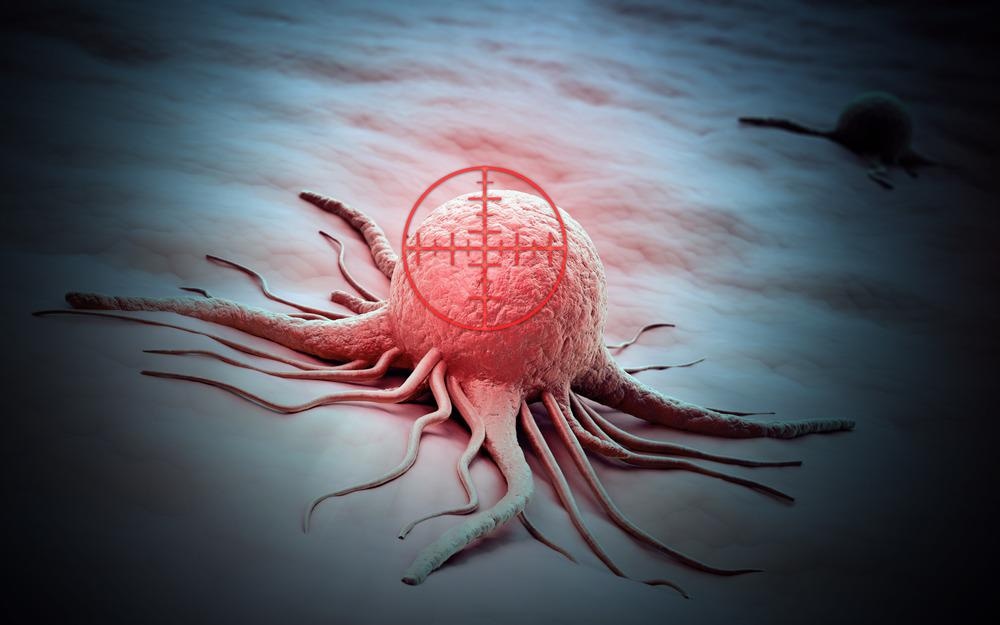Scientists have recently engineered a biofunctionalized graphene oxide (GO) nanoplatform, with high drug loading capacity and controllable drug release, for amplified antitumor therapy. This study has been published as a pre-proof in Biomaterials.

Study: Biofunctionalized graphene oxide nanosheet for amplifying antitumor therapy: Multimodal high drug encapsulation, prolonged hyperthermal window, and deep-site burst drug release. Image Credit: Mopic/Shutterstock.com
Graphene and its Derivatives as Nanocarriers and Therapeutic Agents
Graphene is a type of carbon nanoparticle with sp2 hybridization. This two-dimensional (2D) structure is used in multiple applications, including biomedicine research. Graphene nanosheet contains several active sites and offers appropriate conditions for reactions (e.g., conjugation reactions) with functional groups.
Some of the graphene derivatives, such as graphene oxide (GO) and reduced graphene oxide (rGO) exhibit plasmonic properties, which can transform energy from a laser to heat. These carbonaceous nanoparticles have been applied in various biomedical applications, including magnetic hyperthermia therapy (MHT), photodynamic therapy (PDT), sonodynamic therapy (SDT), and photothermal therapy (PTT).
Recently, researchers have reported that graphene quantum dots (GQDs) were used as PTT and PDT agents for imaging and treating cancer. As graphene and its derivatives can absorb intensive near-infrared (NIR) light, GO-inspired PTT has been applied for tumor ablation.
Previous studies have revealed that GO nanosheets are favorable nanocarriers to load and deliver multiple hydrophobic photosensitizer molecules. One of the key advantages of GO nanosheet-based nanocarrier is the dual capacity, i.e., to deliver drugs without aggregation in physiological solutions and superior therapeutic effects via the combination of PTT and PDT.
Despite having several advantages, one of the limitations of using GO nanosheets is that it contains large surface areas, allowing a higher protein absorption rate. This leads to the formation of “protein corona” when they are in contact with biological media and inhibits tumor targeting.
Researchers stated that a multifunctional GO-mediated drug depot must be designed to attain optimal efficacy of thermo-chemotherapy and resolve these issues. In this context, they employed artificial surface-function assembly of GO nanoparticulate for drug delivery and treatment.
Designing of Nanomedical Systems Based on GO - A New Study
To improve nanomedical systems, scientists have used protein corona to optimize the biological (e.g., tumor) recognition, thereby improving the efficiency of on-target drug delivery. Based on existing literature, the endogenous apolipoprotein A-I (apoA-I) with its natural ability to scavenge receptor-type BI (SR-BI)-overexpressed tumor cells, along with its capacity to escape from reticuloendothelial system elimination, could be exploited for the fabrication of nanoplatform for antitumor therapy. Importantly, apoA-I forming protein corona exhibits a bioconjugation reaction.
A previous study revealed that conjugation of iRGD (CRGDKGPDC), a 9-amino acid cyclic peptide, to apoA-I could benefit nanoparticles during drug delivery because of its high transvascular extravasation. Additionally, it also exhibited specific tumor penetration by sequential recognition of neuropilin-1 (NRP-1) and integrin αvβ3/5.
In the current study, scientists designed a biomimetic GO nanoplatform, based on iRGD conjugated apoA-I (iRGD-apoA-I) protein, with superior tumor targeting ability, biological stability, and a high penetration capacity for amplifying thermo-chemotherapy.
The protein corona was tightly attached with GO nanosheet (iAPG) via electron-deficient PBA moieties. The biofunctionalized GO nanosheets were attached with an iRGD-apoA-I corona in a stable and controlled manner. Doxorubicin (DOX) molecules were entrapped like a sandwich in the GO reservoir through dense π-π stacking, boron-nitrogen (B-N) coordination, and hydrophobic interaction.
The introduction of iRGD-apoA-I corona in GO nanosheet exhibited remarkable drug encapsulation capacity due to the influence of iAPG. In addition, it also enables photothermal conversion and induces triggered release of DOX via extra or intra-cellular stimuli.
Scientists reported that after NIR irradiation, iRGD-apoA-I corona enables longer heat retention from GO, which is attributed to its high efficacy in hyperthermal oncotherapy.
Researchers hypothesized that after administration of iAPG/DOX in humans, it would show greater biocompatibility and would not trigger immunogenic reactions in the blood, or after transvascular extravasation, tumor penetration, and cellular internalization.
This hypothesis was validated via experimental studies and revealed that iAPG/DOX did not interact with serum proteins. Furthermore, the authors reported an improvement in the accumulation and entry of cargoes in targeted tumor sites.
In situ studies revealed that NIR irradiation could disrupt endo/lysosomal membranes for gust release of DOX. In addition, the iAPG structure exhibited significant photothermal transformation and was able to deliver DOX into the tumor cells upon exposure to NIR irradiation. Hence, this approach was found to be capable of effectively restricting tumor growth and metastasis upon NIR irradiation. This strategy provided a synergistic thermo-chemotherapy without causing any peritumoral damages.
Concluding Remarks
The authors stated that their engineered protein corona-based biofunctionalized GO nanosheet elevated the scope of carbon nanoparticles in biomedical applications. The newly designed nano-based drug depot with enhanced hyperthermal window, multimodal drug encapsulation, and burst releases drug could be applied effectively in antitumor therapy.
Reference
Wang, Z. et al. (2022) Biofunctionalized graphene oxide nanosheet for amplifying antitumor therapy: Multimodal high drug encapsulation, prolonged hyperthermal window, and deep-site burst drug release. Biomaterials. https://www.sciencedirect.com/science/article/pii/S0142961222002691?via%3Dihub
Disclaimer: The views expressed here are those of the author expressed in their private capacity and do not necessarily represent the views of AZoM.com Limited T/A AZoNetwork the owner and operator of this website. This disclaimer forms part of the Terms and conditions of use of this website.